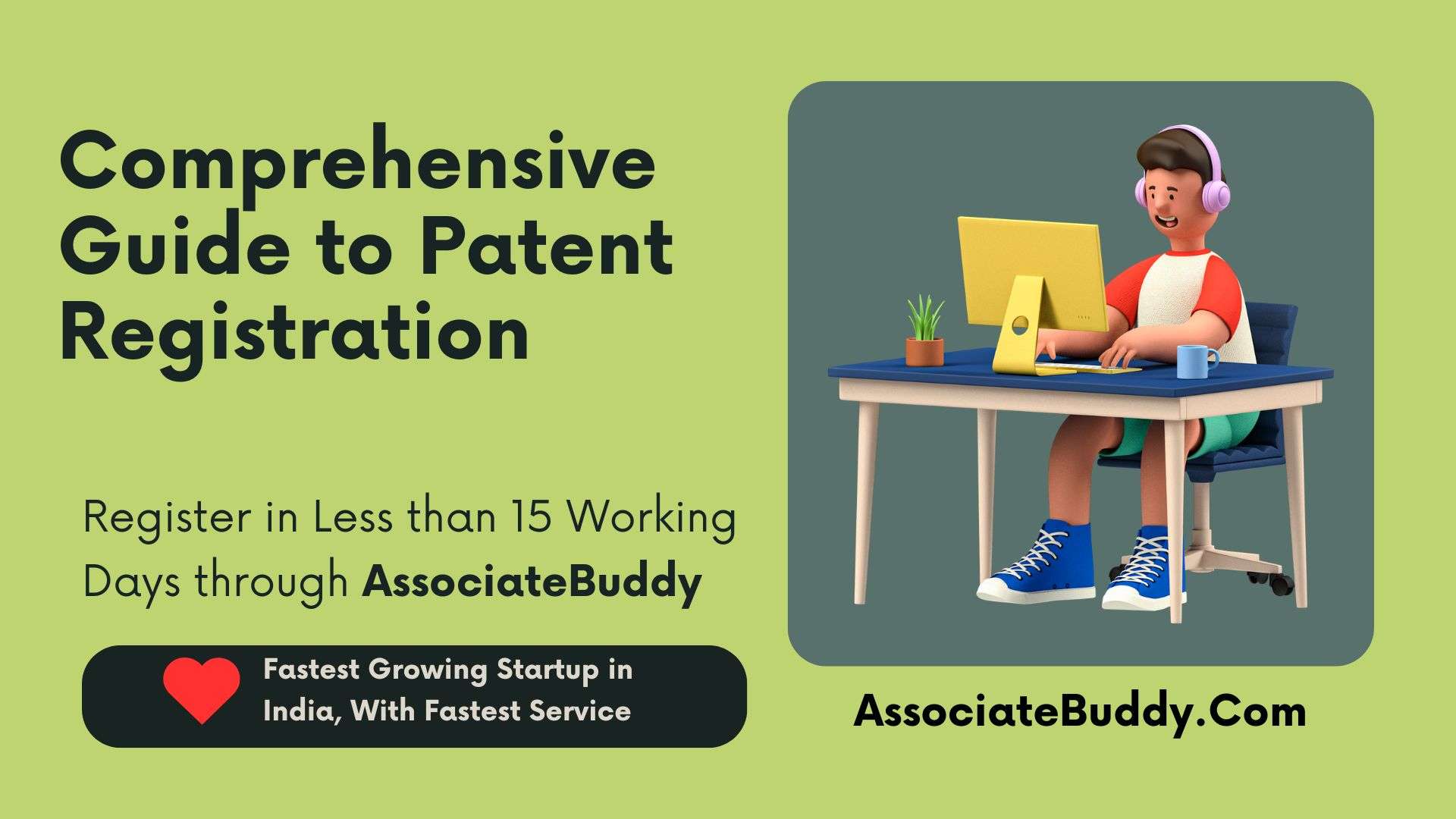Table of Contents
Introduction
In the ever changing world of innovation and technology, intellectual property protection is essential. In order to ensure that inventors’ discoveries are legally recognized and shielded from unauthorized usage, patent registration is an essential procedure that protects their rights. This thorough guide examines the complexities of patent registration, providing information on required paperwork, necessary permissions, benefits, drawbacks, and online registration via Associate Buddy. To protect your intellectual property, whether you’re a seasoned innovator or a young entrepreneur, you must comprehend the patent registration procedure.
What is Patent Registration?
Patent registration is a legal process that provides an inventor with exclusive rights to their invention for a predetermined period, typically 20 years. This right prevents others from producing, using, selling, or distributing the patented invention without permission. Patents are issued for inventions that are industrially applicable, novel, and non-obvious, and that are applicable to a variety of disciplines, including technology, pharmaceuticals, and manufacturing processes. The primary goal of patent registration is to promote innovation by granting inventors a transient monopoly on their creations, thereby encouraging additional research and development.
Documents Required for Registering a Patent
When applying for a patent, several documents must be meticulously prepared and submitted to ensure a smooth registration process:
- Patent Application Form: The prescribed form for filing a patent, detailing the inventor’s information and invention specifics.
- Provisional or Complete Specification: A detailed description of the invention, including its functionality, technical details, and potential applications. A provisional specification can be filed initially, followed by a complete specification within 12 months.
- Drawings and Diagrams: Visual representations of the invention, illustrating its design and functionality.
- Abstract of the Invention: A concise summary of the invention, highlighting its key features and potential benefits.
- Claims: Legal statements defining the scope of protection sought for the invention.
- Declaration of Inventorship: A formal declaration by the inventor, asserting their ownership and originality of the invention.
- Power of Attorney: Authorization for a patent agent or attorney to act on behalf of the inventor during the registration process.
- Proof of Right to File: If the applicant is not the inventor, documentation proving their right to file the patent application.
Essential Licenses and Registrations for Patents
To successfully register a patent, inventors may need to acquire various licenses and fulfill specific registrations, including:
- Patent Search Report: A comprehensive search report identifying similar patents and prior art, ensuring the invention’s novelty.
- Examination Request: A formal request for the patent office to examine the application, assessing its compliance with patentability criteria.
- Government Fees: Payment of applicable fees for filing, examination, and maintenance of the patent.
4. International Patent Protection: For global protection, inventors may opt for international patent applications under the Patent Cooperation Treaty (PCT).
Advantages of Patent Registration
Registering a patent offers numerous benefits to inventors and businesses:
1. Exclusive Rights: Patents give inventors the right to keep others from using their creation without their permission.
Competitive Edge: Patents protect new ideas that give a company an edge over its competitors and help it do better in the market.
3. Financial Benefits: Patents can be licensed or sold, which gives creators more ways to make money.
4. Recognition in the market: Patents give a business authority and recognition in the market, which brings in investors and possible business partners.
5. Promotes new ideas: patent protection promotes ongoing research and development, which moves technology forward.
Disadvantages of Patent Registration
Despite the benefits, patent registration also has certain drawbacks:
1. The process of registering a patent is very expensive. There are filing fees, legal fees, and maintenance fees.
2. It takes a lot of time: the process of registering a patent can be long and often takes years to finish.
3. Public Disclosure: Patents require that the idea be fully disclosed to the public. This could give competitors access to private information.
4. Not enough safety Patents cover inventions for a certain amount of time. After that, the invention is free for everyone to use.
5. Geographical Limitations: Patent security is limited to a certain area, so each country needs its own application, which makes things more difficult and expensive.
Registering a Patent Online through Associate Buddy
Associate Buddy simplifies the patent registration process with expert guidance and comprehensive services. Here’s how Associate Buddy can assist you:
- Expert Consultation: Receive personalized advice from experienced patent agents and attorneys, ensuring your application meets all legal requirements.
- Document Preparation: Professional assistance in preparing and filing all necessary documents, minimizing errors and delays.
- Patent Search and Analysis: Conduct thorough patent searches to ensure the novelty of your invention and avoid potential conflicts.
- Application Filing: Seamlessly file your patent application with the relevant authorities, ensuring timely submission and compliance.
- Follow-up and Maintenance: Ongoing support in tracking the application status, responding to office actions, and maintaining the patent post-grant.
Compliances for Patents
Maintaining compliance is crucial to ensuring the continued protection of your patent:
- Regular Fee Payments: Timely payment of maintenance fees to keep the patent in force.
- Responding to Office Actions: Addressing any queries or objections raised by the patent office during the examination process.
- Updating Ownership Information: Keeping ownership and assignment records up-to-date with the patent office.
- Monitoring Infringements: Vigilantly monitoring for potential patent infringements and taking appropriate legal action when necessary.
Conclusion
A crucial step in safeguarding your innovative concepts and maintaining a competitive advantage in the market is to get a patent. Navigating the complexity of patent registration requires an awareness of the requirements, methods, and advantages. With this knowledge, inventors can proceed with confidence. Simplify the patent registration procedure with Associate Buddy’s experienced advice and get the protection your inventions deserve. For additional information and to begin the process of registering your patent today, visit Associate Buddy .
References
Here are some Indian government websites for patent registration


